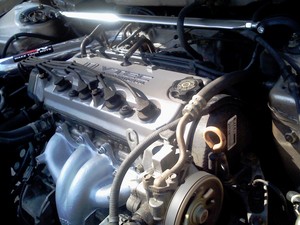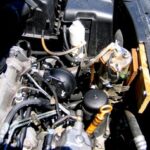This is the basic of basics in terms of aftermarket performance. The cold air intake(CAI). But there’s a lot more to it than slapping it on and saying you just bumped your horsepower up by 15. In fact, the gains are minimal, 2-3hp AT MOST. Is it worth it? I’d say so.
Lets look at the science behind it all.
Combustion occurs when you mix air, fuel, and add a spark. The more air/fuel, the bigger the boom. Stock intakes draw air from inside the engine bay, and if you’ve ever hovered over an engine after a few minutes of driving, you’ll notice it is blazing hot. So the CAI draws in air from outside the engine bay, in most cases under the fender well. What makes cold air better? Well it’s denser. The denser the air, the more of it you can put in the cylinder. That’s not all folks. The more cold, clean air you add to the air/fuel mixture, the better the fuel burns. Cleaner burning means better gas mileage! Of course, too much air makes the mixture lean, which is also bad. Here’s a quick lesson:
ideal air/fuel ratio(at idle) = 14.7:1 which means you want 14.7 parts air for every 1 part of fuel
too much fuel = rich mixture
too little fuel = lean mixture
Fortunately for us, the cold air intake doesn’t provide enough extra air to cause a problem. Yay.
So the air the stock intake is drawing is warm. Is that all? Rhetorical question. Of course it’s not all.
Never forget the accord is a family car. The intake was designed to reduce engine noise. This engineering called for an extremely restrictive intake. The air travels from the engine bay, to through the resonator, then through the subpar paper filter, through plastic tubing, and finally to the throttle body. Thanks Honda.
Cold air intakes provide high-flow filter and 3″ aluminum tubing, providing us with a smooth, unrestricted pathway.
A quick Google gives us tons of different brands and what not. All the high-end name brands will be generally in the same $150-300 price range. The three big dogs are AEM, K&N;, and Fujita, with Weapon-R moving up quickly. So which one do I recommend? None of them.
Every intake is a piece of aluminum tube with a filter on the end of it. They are all shaped the same and look the same. Go on eBay and snag a $20 one. Put this on a dyno against all the other brands and you will never see a difference. If you do go this route, make sure you snag a name brand FILTER. EBay ones are horrid, but the piping is the same none the less. Go with the AEM Dryflow filter (available at any local parts store). All you have to do is run it through water to clean it. The others require this oil crap that’s not worth the mess.
There is one exception. AEM makes a type of intake called the V2. It’s more expensive, but has actually proven to generate more horsepower than the other brands.
Installation takes all of 30 minutes. All you need is a few basic tools: a ratchet for the removal of stock parts and a screwdriver for
Remove ALL stock intake parts, up to the throttle body. Start with the air filter box, and then the main tubing. There is also a small tube attached to the main tube that goes to the valve cover. Use pliers to loosen the clamps, but keep it attached to the valve cover. You’ll notice below the air filter box sits the resonator. The easiest way to remove this part is to go underneath the car, remove the splash guard (be careful not to break any tabs), and find the two bolts holding it in place. Maneuver the resonator out from under the car.
Now just use the rubber couplers to attach the throttle body to your shiny new aluminum tubing and use the ring clamps to hold it all together. Do the same thing on the other end with the filter.
Now that your filter is so close to the ground, you need to be aware of hydrolock. Hydrolocking is when your filter becomes completely submerged, and water is sucked into the engine. Ladies and gentleman, water does not combust and will cause serious damage to your engine. This is RARE. I’ve only heard of a few cases where it’s happened and is easily avoided by not driving through 3 foot puddles. If you’re going through that much water, you have other problems to worry about.
A note of short ram intakes:
This type of aftermarket intake doesn’t dip down into the fender well. It still draws air from the engine bay, but still eliminates all the restrictions set by the stock intake. It also eliminates any chance of hydrolocking. Most eBay cold air intakes come in two separate pieces, and thus can be converted into a short ram intake.
So now that your intake is installed, take it for a test drive! The first thing you’ll notice is the nice growl at 2-3k rpm range, not to mention an extra kick at wide-open throttle.






